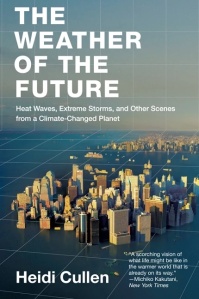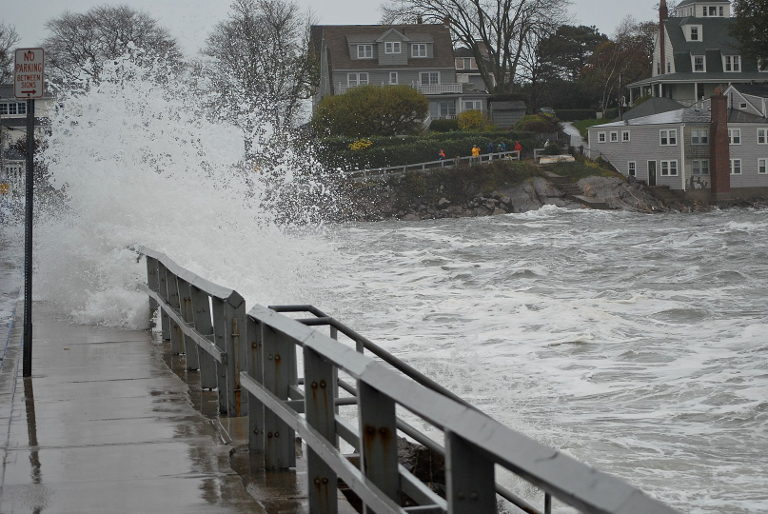The Weather of the Future
Heidi Cullen
Harper, 2010

Heidi Cullen, Director of Communications and Strategic Initiatives at the Monterey Bay Aquarium Research Institute, opens The Weather of the Future with an anecdote from one of her first seminars on climate change. After her presentation a man from the audience approached her, saying he enjoyed the lecture and found it eye-opening. He then asked a question.
“Do you think I should sell my beach house?”
Cullen, in turn, had a revelatory moment as she considered how to answer.
“This is the only way a lot of people can truly connect to the issue of climate change — via a long-term investment like real estate.”
She realized that the scientific community had failed to communicate the threat of climate change in tangible terms, terms that make climate change real and experienced in the present tense. Scientists had not given people the language and concepts to recognize the impacts of climate change in their lives, to understand that change is happening already, that we are feeling these effects in the present. It’s real here and now.
The popular conception is that climate change will come, that the beach house will some day be at risk — but not today. People relate to climate change as a distant process in time and, to a lesser extent, in geography. Scientists haven’t given people the tools to connect the dots between all the disparate stories of climate effects and to connect those stories to their own experiences. Most people have the impression that even scientists are saying climate change is the future. Perhaps. It is not the immediacy of “sell the beach house now”.
And yet that is exactly what it is: “Sell the beach house now!” The future will be too late. There may not be a beach. There certainly is not going to be much of a market for that house — one with flooding issues, increasingly saline drinking water, and the occasional toxic red tide washed up on the front lawn. This might already be true for many beach house properties.
So Cullen set out to connect those dots between effects and people, between the story science is telling us and the lived experience of that story. The Weather of the Future is the result.
First, there is the terminology. She does not call her book The Climate of the Future. It’s weather, that which we all experience day to day. Weather is now; climate is long-term both forward and backward in time. Weather is what we know, but climate is what makes the weather. Weather is what destroys the beach house but climate change is making those destructive events far more likely and frequent. Weather is tangible. It’s also easier to relate to how it might change. We know what today’s weather is; we are less sure what today’s climate is. So if there is a discussion of change in the future, then a better comparison is the weather of the present with weather in the changed future. And that is what she does.
Another term: future. Cullen wants to show that climate is changing now, that effects of change are not awaiting on some dim horizon that none of us are going to experience. Even within the world of science, there has not been that sense of urgency. As recently as a couple decades ago, climate scientists were talking about changes that would happen in the 22nd century. There was not a sense that climate change was upon us, but that it would come some decades down the road. And while we all theoretically know we should not consign any of our descendants to immiseration, it is difficult for most people to make room in their lives for concern about people they will never know.
But it’s not just the 22nd century that will suffer. It’s not even just the next generation, our children. It is us now. Large portions of this planet in the present are suffering now, and all of the planet is affected — at all scales, from “my entire town is gone” to “must wear a mask in public”. These days, scientists are no longer talking in terms of decades; they are all saying it’s here and now. If the goal is to reach people with this message of urgency, the future Cullen describes should be near, not distant. So this is what she does.
After a brief but thorough section explaining climate, weather, what we know and how we know it (which ought to be required reading in every high school science curriculum), Cullen chooses seven regions around the globe as illustrative cases. All are already experiencing change, mostly debilitating. All are going to see even more drastic change in the near future. She chooses some places that are not human-centered and some that are, but all the effects are related in human terms. For example, she discusses the destruction of the Great Barrier Reef — which in itself is a tragedy. But she further relates that to loss of income, loss of resources, loss of livelihood in human communities. There are dollar signs implied. These are effects people can comprehend, readily and viscerally.
Cullen describes the weather in each of these regions, in the present and in the past. She shows how it has already changed and what the effects of those changes are today. She talks with people who are doing science in these places and with people who are living in these places. She records their experiences, their responses, their fears. When she has painted a clear picture of the weather today and its effects, she then faces the future. She selects several representative time periods in the near future and makes the best weather prediction science can deliver for each. She predicts both weather and the effects of weather. The time periods she selected were near-term enough in 2010 when she wrote this book that many of them have passed. Her predictions are eerily accurate in some cases.
However, if there is a complaint about this book, it’s that she did not foresee just how bad it would get in eleven short years. But this is not a fault. She could not have foreseen because the models she used could not predict a good number of climate change effects, not even just on the weather. And there are many effects that go beyond weather, that are not going to be included as variables in the already highly complex predictive models.
For example, climate models are not going to predict effects like the increasing spread of contagious diseases. These are tangential effects, caused by climate change but not directly, not predictable by modeling. They are logically predictable effects though. Ten years ago it was possible to say that a pandemic would happen as climate (and direct human activity) pushed humans and disease vectors like mosquitoes in closer proximity. Scientists did say that. This pandemic was all but named by then. But there are also climate changes and effects of change that are not predictable. Things that are unprecedented, those unknown unknowns, the ugly Black Swans.
We are already in Black Swan territory in a frightening number of ways. Things we could never have predicted because they never happened before, because we had no reason to expect them to ever happen, are happening. Now. Take this week in Texas. We’ve known that the polar vortex can make nasty winter weather far south of the Arctic for many years now. I don’t believe that was known when Cullen was writing, but even if it was, what was not known until this very week is that these bulges in the Arctic air flow could lead to storm systems that can cover the entire North American continent in ice. This was not predictable. Scientists are currently struggling to understand what happened and why. Covering Texas in ice is a climate change Black Swan. This is unpredictable weather.
You see, the real problem with predicting the weather of the future is that the climate is changing. Sounds simplistic, doesn’t it? Isn’t that what the models are supposed to be modeling? The changes? Yes, they are. Except the models can only predict things that can be predicted — variables that we understand sufficiently to incorporate into models. We must at least know these variables exist before they get plugged into an equation. We can’t predict Black Swans. But the climate of the future, that which is driving the weather, is different from anything we have experienced. It is riddled with Black Swan things that we’ll learn about as they happen. We can’t look at the past for help. We have no data for our modeling equations. The models can only predict what we know about, and we’re already leaving that known territory into “Here Be Dragons” land. Until this week, we didn’t know about ice covering Texas, yet here we are. Next week, there will be something else utterly unprecedented somewhere. Because that is the point. It is unprecedented. It has not happened before. It is changing. And we can’t predict everything about that change. We can predict only what we already know about.
Again, this inability to predict the magnitude of effects we’re already experiencing just eleven years on is not a fault in the book. But I do think perhaps Cullen might have talked a little more about things like tipping points and unknown unknowns. Or perhaps she might have allowed for a bit more uncertainty. For example she predicted Hurricane Sandy down to wind speed accuracy (more or less, she named him Homer) with one major difference — Sandy veered off into the Atlantic in the eleventh hour, making a mess but leaving no lasting effects other than the political will to adapt the city to climate change (so… two big differences, I suppose). Moreover, the way she framed the prediction in declarative terms made it feel like there was little chance of Sandy hitting Manhattan — just two years before Sandy did hit Manhattan.
Honestly, I don’t know how else to frame predictions like that. “We’re all going to die” is probably not effective messaging, or even helpful, however accurate. But my feeling is that we do need to hear more declarative statements like “Sell the beach house now!” from science and modeling. And scientists really need to humble ourselves a bit so we can communicate just how little we know and are able to predict — and how those unpredictable things are almost never going to be good. Because change rarely is universally good. It’s disruptive. Always. Change hurts somewhere every time. In any case, I think we need people to be a bit more worried about themselves in the present, perhaps even worried about what we can’t see, so that we might stand a chance of being prepared for what we don’t know. We need to be a bit unsettled now if we are to take on the enormous task of mitigating the effects of human-mediated climate change on the weather on the future. Else why would we take on that task?
And yes… Sell the beach house now.
©Elizabeth Anker
Teaser photo credit: By The Birkes – https://www.flickr.com/photos/brbirke/8136033826/, CC BY 2.0, https://commons.wikimedia.org/w/index.php?curid=22459402





